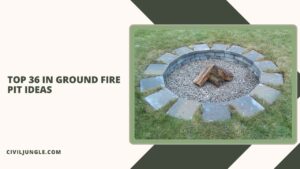Backyards are a beloved space in many homes, serving as a private oasis to relax, entertain and spend quality time with loved ones. While landscaping and furniture play a big role in creating a beautiful backyard, often the … [Read more...]
Top 38 Backyard Gate Ideas
A backyard gate can serve as a functional and decorative element in any outdoor space. It not only provides security and privacy, but also adds character and charm to your backyard. With endless design possibilities, choosing … [Read more...]
Top 40 Sunroom Extension Ideas
Sunrooms are a popular addition to homes, allowing homeowners to enjoy the warmth and beauty of the outdoors while still being protected from the elements. However, with so many options and designs available, it can be … [Read more...]
Top 24 Patio Makeover Ideas
Looking to transform your outdoor space into the ultimate relaxation hub? Look no further than these top 24 patio makeover ideas. From simple DIY projects to complete redesigns, we have compiled a list of the most stunning and … [Read more...]
Top 30 Patio Light Pole Ideas
Having a well-lit patio can completely transform the look and feel of your outdoor space. Whether you’re looking to create a cozy ambiance or add a touch of elegance, the right patio light pole can make all the difference. With … [Read more...]
Top 38 Outdoor Home Lighting Ideas
Outdoor home lighting is an essential aspect of any home’s exterior design and functionality. Not only does it enhance the aesthetic appeal of a house, but it also provides safety and security to homeowners. With the advancement … [Read more...]
Top 38 Outdoor Deck Railing Ideas
Decks are an essential part of any outdoor space, providing a comfortable place to relax and enjoy the outdoors. However, it’s not just the deck itself that adds character and style to the outdoor space, but also the deck … [Read more...]
Top 40 Inground Pool Ideas for Backyard
Having an inground pool in your backyard is a dream for many homeowners. Not only does it provide a refreshing escape from the summer heat, but it also adds value and visual appeal to your property. However, with numerous design … [Read more...]
Top 36 in Ground Fire Pit Ideas
Welcome to our article about the top 36 in-ground fire pit ideas. As the temperatures begin to drop and the leaves start to change, many people are looking for ways to extend their outdoor living season. Fire pits are a popular … [Read more...]
Top 22 Gifts for Outdoor Patio
As the weather warms up, it’s time to start thinking about spending more time outside. And what better place to relax and entertain than your outdoor patio? Whether you’re looking to spruce up your own space or searching for the … [Read more...]
Top 24 Easter Porch Decorations
As the Easter holiday approaches, many people are looking for ways to spruce up their homes and add some festive cheer to their surroundings. One area that often gets overlooked is the porch, yet it is an important space that … [Read more...]
Top 38 Backyard Cover Ideas
As the warmer months approach, many homeowners are eager to spend more time outdoors in their backyards. However, excessive heat, rain, or bugs can put a damper on outdoor gatherings. That’s where backyard covers come in – … [Read more...]
Top 32 Balcony Seating Ideas
Welcome to our article on the Top 32 Balcony Seating Ideas! When it comes to outdoor spaces, the balcony is often an underrated and overlooked area. However, with the right design and seating arrangements, the balcony can become … [Read more...]
Top 40 Backyard Sitting Area Ideas
When the weather is nice, there’s nothing quite like relaxing in your own backyard oasis. A well-designed sitting area can serve as a peaceful retreat, a place to entertain guests, or a casual spot to spend time with family and … [Read more...]
Top 30 Backyard Living Ideas
As the weather warms up and the days become longer, many of us turn our focus to our backyard spaces. The backyard has become not just a place for barbecues and gardening, but an extension of our living space. It’s where we can … [Read more...]
Top 36 Backyard Fire Pit Ideas Landscaping
A backyard fire pit is a perfect addition to any outdoor space, providing warmth, ambiance, and a gathering place for friends and family. But why settle for a plain and simple fire pit when you can turn it into a stunning focal … [Read more...]
Top 32 Under Deck Lighting Ideas
Under deck lighting has become a popular trend in outdoor design, providing both functionality and aesthetic appeal to any outdoor space. From creating a cozy atmosphere for gatherings to increasing safety and visibility, under … [Read more...]
Top 36 Terrace Furniture Ideas
Summer is just around the corner, and with warmer temperatures and longer days, many of us are itching to spend more time outdoors. And what better way to take advantage of the beautiful weather than by updating your terrace … [Read more...]
Top 36 Small Backyard Deck Ideas
A small backyard doesn’t mean you have to sacrifice on style and functionality. In fact, a well-designed deck can transform a limited outdoor space into a stunning oasis. From cozy reading nooks to beautiful entertaining areas, … [Read more...]
Top 34 Rock Patio Ideas
Summertime is the perfect season for outdoor gatherings and relaxation, and what better way to enjoy the warm weather than on a rock patio? In addition to being a beautiful and durable material, rocks can also add a touch of … [Read more...]
Top 30 Patio Flagstone Ideas
Patios are a popular feature in many homes, providing a space for outdoor entertaining, relaxation, and enjoyment of the natural surroundings. One of the most popular materials for creating a stylish and durable patio is … [Read more...]
Top 32 Patio Accessories Ideas
Patios are a popular outdoor space for relaxing, entertaining, and enjoying nature. And what better way to enhance this space than with some stylish and functional accessories? From furniture to lighting to décor, there are … [Read more...]
Top 30 Outdoor Wall Planter Ideas
Outdoor wall planters are a creative way to add a touch of greenery and beauty to any outdoor space. From small balconies to spacious patios, these vertical gardens can transform any bland wall into a vibrant and inviting … [Read more...]
Top 24 Outdoor Wall Fountain Ideas
Outdoor wall fountains have become a popular addition to many homes and outdoor spaces. Not only do they provide a beautiful aesthetic, but they also create a peaceful and relaxing ambiance. With so many options available, … [Read more...]
Top 36 Outdoor Pizza Oven Ideas
Pizza has long been a popular and beloved dish, with its crisp crust, gooey cheese, and endless topping options. However, the experience of making and eating pizza reaches a whole new level when enjoyed in the great … [Read more...]
Top 36 Lanai Enclosure Ideas
As summer draws near, many homeowners are starting to think about ways to spruce up their outdoor living spaces. One popular option is a lanai enclosure, which provides a versatile and comfortable space for entertaining, … [Read more...]
Top 38 Home Exterior Paint Ideas
When it comes to curb appeal, the exterior paint of a home can make all the difference. Whether you are looking to refresh the appearance of your current home or starting a new construction project, choosing the perfect exterior … [Read more...]
Top 28 Diy Backyard Shade Ideas
Summer is here and so are those scorching hot days spent in the backyard. While the sun is definitely enjoyable, too much of it can quickly become unbearable. This is where backyard shade ideas come in to play. Whether you want … [Read more...]
Top 36 Deck Furniture Layout
As the summer season approaches, many homeowners are looking for ways to revitalize their outdoor living spaces and create the perfect spot for relaxation and entertainment. One of the key elements in achieving this is designing … [Read more...]
Top 30 Covered Outdoor Living Space Ideas
Outdoor living spaces have become a popular trend in home design, and for good reason. These spaces not only extend your living area, but they also allow you to enjoy the beauty of nature while still being in the comfort of your … [Read more...]
Top 22 Cheap Fire Pit Ideas
A fire pit in your backyard is a great addition to your outdoor living space. Not only does it provide warmth and ambiance, but it also makes for a perfect gathering spot for friends and family. However, fire pits can often come … [Read more...]
Top 30 Backyard Walkway Ideas
Having a beautiful, functional walkway in your backyard can not only enhance the overall aesthetic of your outdoor space, but also make it easier to navigate and enjoy. From natural stone paths to modern concrete designs, there … [Read more...]
Top 18 Sunroom Decorating Ideas on a Budget
As spring approaches and the warmer weather beckons, it’s the perfect time to start thinking about creating a sunroom. This transitional space between the indoors and outdoors is a perfect spot to relax, entertain, and enjoy the … [Read more...]
Top 36 Privacy Screen for Backyard
Privacy is an important aspect of any home, especially in the backyard. A backyard serves as a sanctuary for many homeowners, a place to relax and unwind after a long day or to entertain friends and family. However, with the … [Read more...]
Top 36 Pool Patio Decor Ideas
Are you looking to liven up your pool area and create an inviting outdoor space for relaxation and entertainment? Look no further! In this article, we have compiled the top 36 pool patio decor ideas to transform your outdoor … [Read more...]
Top 24 Pinterest Outdoor Patio
Welcome to our article on the top 24 Pinterest outdoor patio designs! Whether you’re looking to revamp your current patio or designing a new one, Pinterest is the perfect source for inspiration. With its vast collection of … [Read more...]
- « Previous Page
- 1
- …
- 5
- 6
- 7
- 8
- 9
- …
- 106
- Next Page »



































